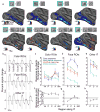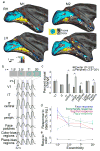Parallel, multi-stage processing of colors, faces and shapes in macaque inferior temporal cortex
- PMID: 24141314
- PMCID: PMC3957328
- DOI: 10.1038/nn.3555
Parallel, multi-stage processing of colors, faces and shapes in macaque inferior temporal cortex
Abstract
Visual-object processing culminates in inferior temporal cortex (IT). To assess the organization of IT, we measured functional magnetic resonance imaging responses in alert monkeys to achromatic images (faces, fruit, bodies and places) and colored gratings. IT contained multiple color-biased regions, which were typically ventral to face patches and yoked to them, spaced regularly at four locations predicted by known anatomy. Color and face selectivity increased for more anterior regions, indicative of a broad hierarchical arrangement. Responses to non-face shapes were found across IT, but were stronger outside color-biased regions and face patches, consistent with multiple parallel streams. IT also contained multiple coarse eccentricity maps: face patches overlapped central representations, color-biased regions spanned mid-peripheral representations and place-biased regions overlapped peripheral representations. These results show that IT comprises parallel, multi-stage processing networks subject to one organizing principle.
Figures








Similar articles
-
Functional architecture for disparity in macaque inferior temporal cortex and its relationship to the architecture for faces, color, scenes, and visual field.J Neurosci. 2015 Apr 29;35(17):6952-68. doi: 10.1523/JNEUROSCI.5079-14.2015. J Neurosci. 2015. PMID: 25926470 Free PMC article.
-
Color-Biased Regions of the Ventral Visual Pathway Lie between Face- and Place-Selective Regions in Humans, as in Macaques.J Neurosci. 2016 Feb 3;36(5):1682-97. doi: 10.1523/JNEUROSCI.3164-15.2016. J Neurosci. 2016. PMID: 26843649 Free PMC article.
-
Retinotopy versus face selectivity in macaque visual cortex.J Cogn Neurosci. 2014 Dec;26(12):2691-700. doi: 10.1162/jocn_a_00672. Epub 2014 Jun 4. J Cogn Neurosci. 2014. PMID: 24893745
-
More Than the Face: Representations of Bodies in the Inferior Temporal Cortex.Annu Rev Vis Sci. 2022 Sep 15;8:383-405. doi: 10.1146/annurev-vision-100720-113429. Epub 2022 May 24. Annu Rev Vis Sci. 2022. PMID: 35610000 Review.
-
The Organization and Operation of Inferior Temporal Cortex.Annu Rev Vis Sci. 2018 Sep 15;4:381-402. doi: 10.1146/annurev-vision-091517-034202. Epub 2018 Jul 30. Annu Rev Vis Sci. 2018. PMID: 30059648 Free PMC article. Review.
Cited by
-
Face Processing Systems: From Neurons to Real-World Social Perception.Annu Rev Neurosci. 2016 Jul 8;39:325-46. doi: 10.1146/annurev-neuro-070815-013934. Annu Rev Neurosci. 2016. PMID: 27442071 Free PMC article. Review.
-
Brainnetome atlas of preadolescent children based on anatomical connectivity profiles.Cereb Cortex. 2023 Apr 25;33(9):5264-5275. doi: 10.1093/cercor/bhac415. Cereb Cortex. 2023. PMID: 36255322 Free PMC article.
-
Area TEO and "Area ?": cytoarchitectonic confusion corrected by connectivity and cortical ablation.Brain Struct Funct. 2018 Nov;223(8):3515-3529. doi: 10.1007/s00429-018-1714-1. Epub 2018 Jul 26. Brain Struct Funct. 2018. PMID: 30051283 Free PMC article. Review.
-
Parcellating Cerebral Cortex: How Invasive Animal Studies Inform Noninvasive Mapmaking in Humans.Neuron. 2018 Aug 22;99(4):640-663. doi: 10.1016/j.neuron.2018.07.002. Neuron. 2018. PMID: 30138588 Free PMC article. Review.
-
Representation of multiple objects in macaque category-selective areas.Nat Commun. 2018 May 2;9(1):1774. doi: 10.1038/s41467-018-04126-7. Nat Commun. 2018. PMID: 29720645 Free PMC article.
References
-
- Ku SP, Tolias AS, Logothetis NK, Goense J. fMRI of the face-processing network in the ventral temporal lobe of awake and anesthetized macaques. Neuron. 2011;70:352–362. - PubMed
Publication types
MeSH terms
Substances
Grants and funding
LinkOut - more resources
Full Text Sources
Other Literature Sources

